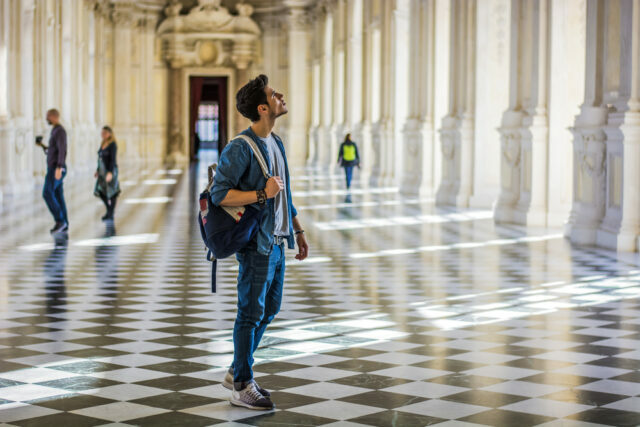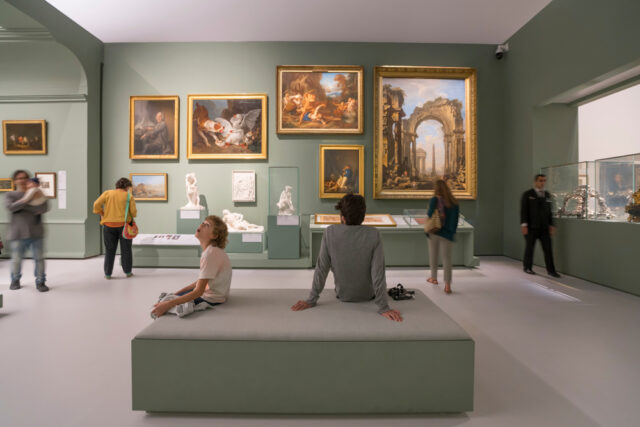
Video analytics in the museum. TOP 7 benefits for the museum business
Video analytics in the museum. TOP 7 benefits for the museum business
Do you know that there are more than 5 thousand museums in Russia, of which 2.7 thousand objects are financed as”culture” from various budgets? At the same time, to open a private museum (the goal is to make a profit), it is enough to open the status of an individual entrepreneur or a company (LLC). A museum organization can also work as a non-profit association if it is financed by donations, external funding, and participants’ contributions. In one case or another, the museum needs a system to ensure security and collect marketing information. These functions are easily performed by video surveillance and video analytics. This is what our article is about.
The specificity of museums as objects of video surveillance
Museums have several specific features when installing video surveillance:
- The need to ensure the safety of exhibits without restricting the access of visitors.
- Video surveillance in museums is conducted around the clock, and the video archive must be preserved for 15 days.
- Under supervision should be:
- each exhibit;
- all halls;
- warehouses and storages;
- roof and windows of the upper floors; stairs and foyer;
- entrances / exits;
- adjacent territory.
- The halls should be equipped with cameras with thermal imagers, laser detection systems and/or IR illumination, as well as motion sensors. It is advisable to install a camera with a motion sensor.
- Many museums are located in historic buildings where hidden cables cannot be laid, so it is convenient to use a wireless remote monitoring system.
The goals of introducing video surveillance and video analytics in museums are:
- ensuring the safety of exhibits and other property;
- predictive analytics. Read the article “Predictive Analytics in Video Surveillance. Business goals and opportunities ”;
- collecting marketing data about visitors;
- control of museum staff.
TOP 7 benefits for museums and the museum business
Museum video content analysis software such as Faceter is capable of providing many functions. In particular, we are talking not only about ensuring the safety of the object and exhibits but also about several other essential functions.
Security
The prospect of using intelligent video analytics in museums lies in the prevention of offences and crimes. Machine vision, combined with the use of clear scenarios and specific patterns of a violation, makes it possible to identify a potential violator before the offence is committed (for example, before approaching particularly valuable exhibits).
INTERESTING FACT: in 2013, the theft of paintings by Monet, Picasso and Matisse (totalling $ 24 million) took place in Rotterdam at the Kunsthal Museum. The same year, a Romanian citizen pleaded guilty to this theft and … filed a lawsuit against the museum leaders. The claim was that the robbery turned out to be too simple and easy, and the security systems were not of high quality (they did not work).
Events investigations
The camera in the museum can be used to investigate events that have occurred.
VIDEO ROBBERY: Videos of robbers who entered a Dresden museum at night armed with flashlights and axes leaked on the web in the fall of 2019. The police have reconstructed the exact timeline of the event.
Visitor movement templates
To improve visitors experience and manage their flows, museums create patterns of people movement:
- study the directions of visitors movement through the halls;
- identify which exhibits are of the most significant interest;
- define how enters and exits are used;
- analyze attendance (monthly, weekly, daily, hourly);
- prepare staff for anticipated peak visits.
Heat maps are used to visualize internal processes.
Involvement and control of personnel
Every third robbery of museums is committed in collaboration with employees.
For example:
- in 1994 an Egyptian glass bowl (3rd century BC) was stolen from the Hermitage. The perpetrator is a museum electrician;
- the same year, two guards of the legendary museum “distinguished themselves” – they stole three Roman gold coins;
- in 2015 valuable prints and photographs disappeared from the Hermitage. As the investigation showed, the criminal employee of the museum has been “collaborating” with the famous antique dealer for three years;
- in 2016, a scandal thundered: the curator of the Hermitage Larisa Zavadskaya took out valuable exhibits from the museum. Within several years, she has appropriated more than 220 units worth at least 130 million rubles. She died at the workplace of a heart attack during a checkup, and her partner-in-crime husband received five years in prison.
That is why work process control and video surveillance are a mandatory requirement in the museum business. Additional video analytics capabilities:
- receiving data on museum workload and managing visitor flows;
- planning staff needs for the year, month, week, day, during holidays and weekends;
- setting up quick notifications about unplanned queues.
Collection of marketing data
A modern online camera in a museum can collect and analyze a large amount of marketing data:
- total number of visitors, including unique and repeat visitors;
- classification of people by sex and age characteristics;
- face recognition (up to 99.8%) and emotions of visitors;
- detection of people from VIP and “black” list;
- counting the time spent in the hall, at each exhibit, in a souvenir shop, at the reception;
- detailing the working time of employees;
- compliance with regulations;
- quick messages to your mobile device.
Improving building maintenance
To optimize the costs of maintaining the museum building, it is advisable to configure the “smart office” functions. In particular, video analytics can predict and record:
- reaching a predetermined threshold of visitors in a specific room;
- maintaining a comfortable environment (temperature, humidity);
- energy savings.
Control of cash transactions
Video surveillance in the checkout area and the museum’s souvenir shop performs two functions:
- control of cash transactions and prevention of personnel fraud. Details in the article “Control of cash transactions: TOP-7 types of fraud and errors at the cash register“;
- increase in profits by analyzing traffic flows, visitor activity.
Conclusion
Intelligent video analytics provides museum staff, marketing and security services with a variety of valuable information. It is used for effective workforce planning, managing people’s flow, and delivering better service to its audience.














